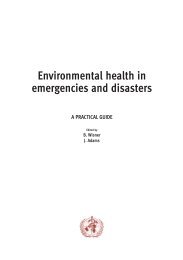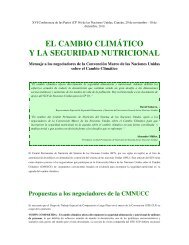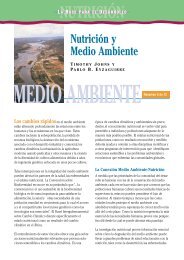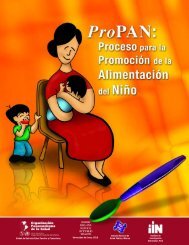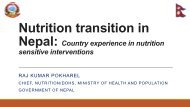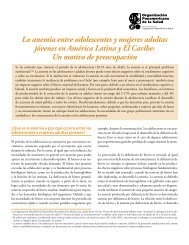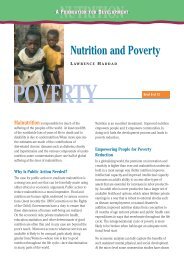SCN News No 36 - UNSCN
SCN News No 36 - UNSCN
SCN News No 36 - UNSCN
Create successful ePaper yourself
Turn your PDF publications into a flip-book with our unique Google optimized e-Paper software.
www.unsystem.org/scn FEATURES 25<br />
by the program), and on the baseline levels of schooling (e.g. whether school enrolment and attendance in<br />
primary and secondary school were low or high at baseline) (Adato and Bassett 2007).<br />
The impact of CCTs on the use of health services and health outcomes has also been reviewed, especially in<br />
Latin American countries where most of the experience exists. Overall, the picture again is one of positive<br />
impacts on the use of preventive health services (e.g. increased number and frequency of preventive health<br />
visits), while impacts on immunization coverage and health outcomes are more mixed (see Glassman et al<br />
2007, Lagardeet al 2007). Lack of impact on immunization and health outcomes is believed to be related to<br />
weaknesses in the supply side – i.e. if services are of poor quality, increased attendance is unlikely to lead to<br />
positive health outcomes.<br />
Impacts on child anthropometry are also mixed, but significant and large impacts were found in Nicaragua,<br />
where a reduction in the prevalence of underweight of 6 percentage points in 2 years was found among<br />
children less than 5 years of age (Maluccio and Flores 2005). Results from Mexico also suggest a significant<br />
impact of the programme on reducing childhood undernutrition, but the exact magnitude of impact is difficult<br />
to report, as results differ depending on the round of data collection, the population groups studied, and the<br />
analytical models used (Glassman et al 2007, Lagarde et al 2007). Overall, however, the results are<br />
consistent in showing a reduction in stunting prevalence. There is also evidence of a small reduction in the<br />
prevalence of anaemia among children participating in the programme in Mexico, but no impact was found in<br />
Nicaragua (Rivera et al 2004, Maluccio and Flores 2005).<br />
This brief overview of the impact of CCT programmes on health and nutrition outcomes raises several<br />
questions. Although the programmes clearly seem to increase the demand for health services, the impacts on<br />
health and nutrition outcomes are less consistent. As noted above, this is likely due to variations in the quality<br />
of health services, and in the availability of supplies such as vaccines or micronutrient supplements at the<br />
health centers. The impacts on child anthropometry outcomes, which in the case of Nicaragua are of large<br />
magnitude (6 percentage points in 2 years) are also observed in some, but not all countries where this<br />
outcome was assessed.<br />
The main factor that complicates interpretation of the nutrition impacts of CCT programmes is the lack of<br />
initial conceptualization of what these programmes are expected to achieve in terms of nutritional impacts,<br />
and how they may achieve these impacts. There is a dearth of information throughout the CCT evaluation<br />
literature on what the mechanisms by which these programmes are expected to improve nutrition are;<br />
similarly, there is lack of analysis, using appropriate modelling techniques, of the mechanisms by which<br />
nutrition improvements actually do occur (or not). Future evaluations of these programmes should use a<br />
programme theory framework to conceptualize and document the specific pathways by which CCT<br />
programmes are impacting nutrition (Rossi et al 2004, Loechl et al forthcoming). Referring to Figure 1, we<br />
can expect that CCT programmes could affect nutrition through a combination of several pathways; one<br />
potential pathway is through increasing income and access to food, thereby increasing household food<br />
consumption; another pathway may be through improved child care and feeding practices (e.g., as a result of<br />
greater maternal control over income and/or improved knowledge from exposure to nutrition education); and<br />
another potential pathway is through improved water and sanitation and/or greater use of health services and<br />
the resulting prevention and better control of infectious diseases. Understanding the pathways of impact of<br />
CCTs is important because it will help better define the package, dose, and combinations of interventions that<br />
should be incorporated in these programmes to enhance their nutritional impact, and it will allow more<br />
effective and successful replication and scaling up of the programmes in different contexts. As CCTs are<br />
becoming increasingly popular and are being replicated widely in Africa and Asia, it is time for nutritionists to<br />
start paying attention to how these programmes’ nutrition intervention packages are designed and<br />
implemented, which mechanisms and pathways ensure maximum impacts on nutrition, and how they can be<br />
replicated and scaled up most successfully. It is also important to collect appropriate data on the supply side<br />
to better understand the role of service delivery and quality in achieving nutritional impacts. Through the<br />
conditions they impose on households, CCT programmes necessarily establish a link to health systems and<br />
thus may provide an opportunity for mainstreaming and strengthening nutrition within the health sector.<br />
back to contents <strong>SCN</strong> NEWS # <strong>36</strong>




